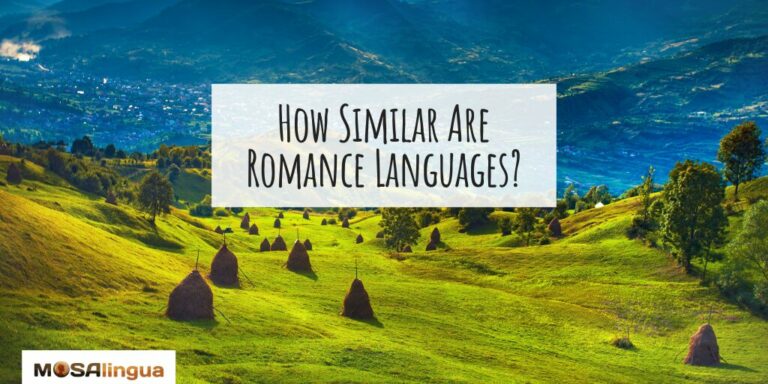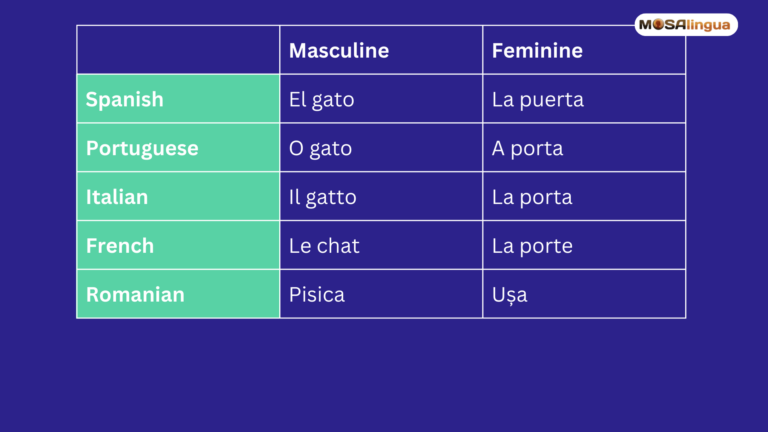Ever wondered which language you should learn? There are so many that it can be difficult to choose! But it can be helpful to think about languages in terms of families. One of the most well-known Western language groups is the family of Romance languages. This includes French, Italian Spanish, Portuguese, and Romanian. These are the main ones, though there are others… Keep reading to find out what they are, and just how closely these languages are intertwined.

Romance Languages: How Similar Are They?
¡Buenos días, amigo!
Bom dia, amigo!
Buongiorno, amico!
Bonjour, mon ami !
This is the same greeting in four languages: Spanish, Portuguese, Italian, and French. Can you see some of the similarities they share?
Here’s another example:
¿Un poco de agua?
Um pouco de água ?
Un po’ d’acqua ?
Un peu d’eau ?
There’s a lot of overlap between Romance languages. But how much Spanish can you understand if you speak French, and how close together are Italian and Portuguese? In this article we’ll explore how similar they are, and look at how much bonus knowledge you get by learning one of them.
What is a Romance language?
Interestingly, this name doesn’t have anything to do with how romantic the languages sound (or how swoon-worthy their speakers are). Instead, it originates from the Latin word “rōmānicus” meaning “Roman.”
During the Roman Empire, there were two types of Latin: Classical and Vulgar. Classical Latin was primarily employed in written and official communication. However, in daily life, the language of the “common people” was Vulgar Latin.
As Roman soldiers and traders ventured across lands, they disseminated this version of Latin, which mixed with other local languages and took on new forms in the different regions. Over time, these variants evolved into different languages such as Spanish, French, Italian, Portuguese, and Romanian.
Each of these Romance languages developed its own identity and unique features, but they all share a common origin. There are also a number of regional Romance languages, including Catalan (spoken in the northeast of Spain), Occitan (spoken in the south of France), and Sardinian (spoken in Sardinia, Italy), among other minor languages.
Similarities between Romance languages
Though all Latin-based languages have clear ties to their origins, Italian remains the least changed.
French has traveled furthest in terms of pronunciation. Romanian has changed the most in terms of vocabulary, though it has preserved Latin grammar more faithfully than the other Romance languages.
So what does the Romance language family have in common? Obviously, a lot. Today we’re going to focus on two points of comparison between the five main Romance languages: grammar and vocabulary. The Romance languages are known to have similar grammar forms and sentence structure.
Let’s look at some of the features they all share.
Word order
These languages follow a subject-verb-object word order and use similar prepositions, which you can see in the following examples:
- French: Mon amie lit un livre d’aventures.
- Italian: La mia amica legge un libro d’avventura.
- Spanish: Mi amiga lee un libro de aventuras.
- Portuguese: A minha amiga lê um livro de aventuras.
- Romanian: Prietena mea citește o carte de aventuri.
Verbs
Romance languages also share the verb conjugation system, meaning that verbs are conjugated according to tense, gender, and number (and also the level of formality!).
You can see this with the verb “to love” in the example below. What in most of the languages comes after -m, the last part of the root, is the ending that gives information about the person and the tense. So, for example, the -o in “amo” means that the person is “I” and the tense is present. A lot of information in a single vowel, as you can see!
All Romance languages have two genders (masculine and feminine) and they usually have an ending that indicates which gender the word is (typically, -a for the feminine, and -o or a consonant for the masculine).
Did you notice how similar the vocabulary is (except for the Romanian)?
Prepositions
The use and meaning of prepositions is very similar in all the Romance languages. Take a look at this example:
- French: Je voyage à Madrid avec ma famille pour visiter la ville.
- Italian: Viaggio a Madrid con la mia famiglia per visitare la città.
- Spanish: Viajo a Madrid con mi familia para conocer la ciudad.
- Portuguese: Viajo a Madrid com a minha família para conhecer a cidade.
- Romanian: Călătoresc la Madrid cu familia mea pentru a vizita orașul.
This sentence means “I am traveling to Madrid with my family to explore the city.”
The preposition “a,” which means “to,” is very similar in all the languages as well as “con” (with). Same goes with the last preposition “para,” which means “in order to” and it’s very similar in all the languages. The sentences, except for Romanian, are easily intelligible, aren’t they?
Vocabulary
All Romance languages share a lot of similar vocabulary. This does not mean that the words are exactly the same. Instead, this means that a lot of terms show the same roots and sound more or less similar. Here are some examples of how similar words are among Romance languages:
- French: La clé rouge est sous la table, dans la cuisine.
- Italian: La chiave rossa è sotto il tavolo, in cucina.
- Spanish: La llave roja está debajo de la mesa, en la cocina.
- Portuguese: A chave vermelha está debaixo da mesa, na cozinha.
- Romanian: Cheia roșie se află sub masă, în bucătărie.
As you may have guessed, this sentence means “The red key is under the table in the kitchen” and it’s pretty intelligible in all the languages if you know at least one of them.
The Ethnologue, a huge catalog of languages around the world, uses what they call a “lexical similarity coefficient” to measure how strongly the vocabularies between different languages overlap. As you can see in this table, all five languages show lexical similarities between 71% and 89%.
Spanish and Portuguese, together with French and Italian, are very similar to one another, both with 89% lexical similarity. That’s a lot, isn’t it?
This means that knowing Spanish, for example, will definitely make your life easier if you decide to learn Portuguese and vice versa! And that learning French will set you up for quick success if you ever decide to pick up Italian. Isn’t that incredible?
You can see a couple of examples of just how similar these two languages pairs are in the video below.
Romance languages: Know one to know them all?
So, is it five for the price of one? Yes and no.
Though each of the major Romance languages requires its own dedicated study, knowing one can certainly help you navigate the rest. The time you will need to learn a second Romance language will be much shorter and your motivation will be higher, as you will be able to understand more from the very beginning and, therefore, start communicating with native speakers right away.
What are you waiting for? Start learning a Romance language today!
WATCH – Latin-Based Languages: How Similar Are They?
You can find all the information above (and some additional examples) in Mirari’s video below. The video is in English, but subtitles are available in several languages. Just click on the Settings gear at the bottom right corner.
Subscribe to our YouTube channel!
Go further
If you found this article interesting, you might also enjoy:
Related posts:
Want to start improving your language skills today?
Start learning a new language today

Good news: we can help!
More good news: you can get started for free! Start your free trial now and for the next 15 days, take advantage of the most effective language learning method on the market!
Vocabulary flashcards, videos with subtitles, audiobooks, articles adapted to your level – with MosaLingua Premium (Web & Mobile), you’ll have access to all this and more. Get started right now. It’s free—and risk-free—to try!







Comments